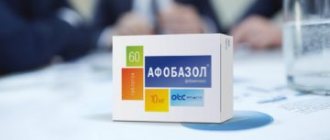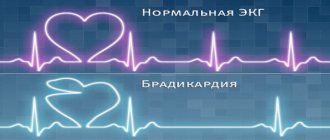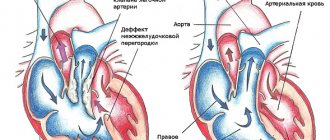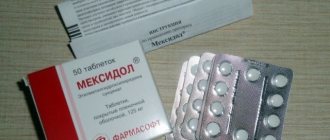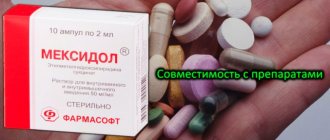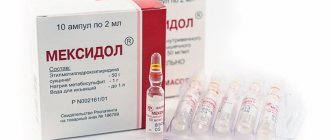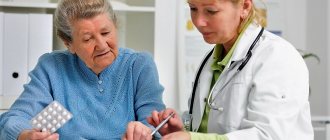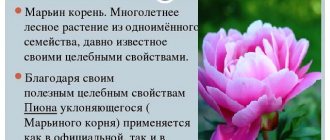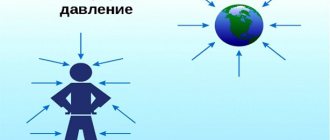Afobazole and Glycine are taken as joint therapy for disorders of the autonomic nervous system, sleep problems, deviant behavior of adolescents and children, and the presence of feelings of anxiety and fear.
The drugs have contraindications for use, for example: Afobazole should not be taken during pregnancy and breastfeeding, Glycine is contraindicated if you are allergic to aminoacetic acid. A course of combined therapy can cause side effects such as nausea and dizziness, severe headaches.
The course of taking Afobazole and Glycine lasts 30 days, but it will be advisable in the acute course of conditions dangerous to the human psyche. It is important to take a 30-minute break between taking tablets. Glycine is placed under the tongue until completely dissolved, while Afobazole is taken in the classic oral way 30 minutes after a meal.
Indications for use of Afobazole and Glycine
Afabazole and Glycine can be used simultaneously; they are absolutely compatible and enhance each other’s effectiveness. Indications for such a combined course of therapy are:
- disorders of the brain of various origins (vascular, traumatic);
- memory problems, absent-mindedness;
- stressful conditions that last for weeks and months;
- problems in the functionality of the vegetative-vascular system;
- inappropriate (deviant) behavior of children and adolescents (it does not correspond to generally accepted norms);
- recovery period after an ischemic stroke;
- exhaustion of the nervous system;
- unstable psycho-emotional state;
- problems with mental state due to quitting smoking and/or alcohol.
Characteristics of Glycine
Glycine is a synthesized amino acid that can be taken as a supplement. It can be used to treat schizophrenia, anxiety (nervousness), insomnia (trouble sleeping), hypoglycemia (low blood sugar) and gout. It may also reduce muscle spasms, symptoms of benign prostatic hyperplasia (BPH), and boost the immune system. Indications:
- Treatment of schizophrenia when used with other conventional medications.
- Treatment of the most common form of stroke (ischemic stroke). Placing glycine under the tongue may help limit brain damage caused by an ischemic stroke if it begins within 6 hours of the stroke. Ischemic drainage is caused by a blockage of a blood vessel (usually a clot) in the brain. Brain cells outside the obstruction do not receive oxygen and begin to die, causing irreparable damage.
- For sleep disorders.
- With a decrease in mental performance in stressful situations and psycho-emotional stress.
Afobazole or Glycine - which is better?
It is impossible to say unequivocally which is better - Afobazole or Glycine, because the first drug is especially effective for anxiety disorders, prolonged stress and problems in the functioning of the central nervous system. But it is practically useless for insomnia, during rehabilitation after a stroke, traumatic brain injuries and encephalopathies. The listed conditions are most successfully corrected by Glycine.
These drugs have similar effects, but it is advisable to prescribe Afobazol in cases where it is necessary to have a quick effect on the nervous system and psycho-emotional background. The fact is that Glycine has a prolonged action, and the first positive changes in health can be noted only after 2-3 weeks of regular use of the drug.
We recommend reading about why you take Glycine before bed. From the article you will learn about the indications and contraindications for taking Glycine before bed, how many tablets you can take at a time, when and how to take it, and what to replace the drug with. And here is more information about how Glycine will help with a hangover.
Comparison of drugs by main characteristics
The drugs Afobazol and Glycine are similar in action, but still differ in individual characteristics.
| Afobazole | Glycine |
| Take 1 tablet three times a day | Prescribed individually, usually 2 tablets twice a day |
| Take the tablet with plenty of water | Place in the sublingual space until completely dissolved |
| Take immediately after meals | The timing of pill use does not depend on diet |
What is the difference
The main difference between the two drugs is that Afobazole is addictive and is not used for therapy in childhood, pregnancy and breastfeeding. In addition, the drug is synthetic, directly affecting the central nervous system. It is recommended for use in acute situations that are dangerous for the patient’s mental state.
Glycine, on the other hand, acts more mildly and mainly has a positive effect on mental abilities. The course of therapy is usually long, the main component is contained in tablets in increased concentration.
Mechanism of action of Afobazole
Drugs prescribed for the treatment of vegetative-vascular dystonia
Doctors do not consider medications to be the main method of treating vegetative-vascular dystonia.
The main emphasis is on a healthy lifestyle and psychotherapy, and medications for VSD are designed to help restore balance in the functioning of the patient’s ANS. If you treat VSD only with the help of medications, after you stop taking them, the symptoms of the disease will return, because vegetative-vascular dystonia is based on disturbances in the functioning of the nervous system.
If you do not find the cause of VSD with the help of psychotherapy and do not change your lifestyle, it is impossible to achieve recovery.
To combat the symptoms of VSD, various drugs are used that have a calming effect, normalize blood supply to the brain, antidepressants, tranquilizers and vitamin preparations.
What drugs to take to treat the symptoms of vegetative-vascular dystonia can only be determined by a doctor, and for each patient all this is selected individually, taking into account contraindications.
What medications do doctors most often recommend for patients with VSD to take?
Anaprilin
Anaprilin is a beta-blocker that acts on beta-1 and beta-2 receptors. Anaprilin, by blocking beta-1 receptors, relieves an attack of angina. If you take anaprilin, the nerve impulse to the myocardium will travel more slowly, this reduces the number of heart contractions and prevents arrhythmia. These symptoms often bother patients with VSD.
Anaprilin, by blocking beta-2 receptors, increases the tone of the bronchi and uterus. Therefore, anaprilin has limited use for pregnant women and for patients with asthma.
Anaprilin, acting on the cardiovascular system, is widely used to treat hypertension. Anaprilin has an effect on the sympathetic nervous system, therefore it allows you to cope with sympathoadrenal crises (panic attacks) - one of the manifestations of vegetative-vascular dystonia.
Anaprilin is contraindicated if the patient has impaired cardiac conduction, hypotension, heart failure, asthma or depression.
Afobazole
Afobazole is a selective anxiolytic (relieves anxiety). Afobazole does not have muscle relaxant properties. Afobazole is used to treat anxiety conditions that also occur in patients with VSD.
In its action, Afobazol combines anti-anxiety and stimulating effects. Afobazole eliminates or reduces tension and anxiety, i.e. symptoms that also appear in vegetative-vascular dystonia. The maximum effect from taking afobazole is achieved by the end of 4 weeks of use.
Afobazole is prescribed to treat a patient’s uncertainty, suspiciousness, and emotional instability.
Afobazole is a non-toxic drug. Afobazole is taken orally after meals.
What contraindications does Afobazole have? Do not take during pregnancy or lactation; afobazole is not prescribed to children.
When interacting with ethanol and thiopental, afobazole does not affect the effect produced by these drugs. Afobazole enhances the anti-anxiety effect of diazepam.
In case of overdose, afobazole promotes drowsiness and sedation.
Gidazepam
Gidazepam is a drug that relieves anxiety. When taken, Gidazepam enhances inhibition processes in the central nervous system. Gidazepam also reduces the excitability of subcortical brain structures. Gidazepam is able to reduce the following symptoms of vegetative-vascular dystonia: anxiety, restlessness, fear, emotional stress. In addition, gidazepam has a vegetative stabilizing and activating effect.
Gidazepam has no effect on affective and hallucinatory disorders. In stressful situations, gidazepam can have a positive effect on the vascular system.
Doctors recommend gidazepam for the treatment of patients with neuroses, which are accompanied by irritability, anxiety and fear. Gidazepam is also effective for migraines, insomnia, and psychopathy, and therefore helps patients with VSD.
Gidazepam is contraindicated in patients with liver disease and myasthenia gravis. Gidazepam is not prescribed during pregnancy and lactation.
Gidazepam is produced in the form of white tablets and should be taken orally.
What side effects does gidazepam have? Slows down the speed of reactions, provokes lethargy, drowsiness, and is addictive. Also, those taking gidazepam have a decrease in concentration and allergic reactions.
Mexidol
Mexidol slows down free radical processes. Mexidol helps increase the body's resistance to hypoxia, has an anti-anxiety effect, and improves mental activity.
Mexidol increases dopamine levels in the brain. Mexidol increases the human body's resistance to hypoxia and shock.
Mexidol improves metabolism and blood supply to the brain. All this helps patients with VSD.
Mexidol acts due to its antioxidant and membrane protective properties.
Mexidol is used to treat patients with cerebral circulatory disorders, vegetative-vascular dystonia, and mild cognitive disorders. Mexidol has a positive effect in the treatment of anxiety disorders and neuroses.
Mexidol is contraindicated in patients with impaired liver and kidney function. Mexidol is not prescribed during pregnancy or lactation, or for children.
Mexidol is taken intravenously or intramuscularly, selecting the dose individually.
Mexidol enhances the effect of benzodiazepine anti-anxiety drugs, anti-parkinsonian and anticonvulsant drugs. In case of overdose, Mexidol promotes the development of drowsiness.
Mexidol can cause allergic reactions, nausea, drowsiness and dry mouth as side effects.
Neuromultivitis
Neuromultivit belongs to the group of multivitamins and is a combined preparation of B vitamins. What vitamins does Neuromultivit contain? Thiamine plays an important role in the metabolism of proteins, carbohydrates and fats.
Pyridoxine and cyanocobalamin, which neuromultivit contains, are necessary for the normal functioning of the nervous system. Neuromultivit is used to treat neuropathy, various types of neuralgia and vegetative-vascular dystonia.
All vitamins that neuromultivit contains are soluble in water.
Neuromultivitis is taken orally after meals, one tablet one to three times a day. It is not recommended for pregnant or breastfeeding women.
Neuromultivitis in isolated cases can provoke side effects such as tachycardia, nausea, itching and urticaria.
Novopassit
Novopassit is a combined drug with sedative and anti-anxiety effects. Novopassit is an extract from medicinal plants. Novopassit is available in the form of an oral solution or tablets. Novopassit helps reduce anxiety in the patient.
Novopassit is used to treat mental stress, neurasthenia, insomnia, vegetative-vascular dystonia, and diseases of the gastrointestinal tract. Novopassit is contraindicated in myasthenia gravis and children.
The side effects that novopassitis causes are dizziness, drowsiness, stomach problems and weakness.
Novopassit is taken orally, three times a day. The drug can be added to drinks or taken with meals.
Tenoten
Tenoten is a homeopathic medicine. Tenoten has a pronounced anti-anxiety effect with an activation effect. Tenoten leads to increased activity of stress-limiting systems.
Tenoten relieves tension, tearfulness, unstable mood, sweating and dizziness - typical symptoms of vegetative-vascular dystonia. Tenoten does not have a muscle relaxant or sedative effect on the patient. Tenoten can have a neuroprotective effect during hypoxia or intoxication. Tenoten normalizes the levels of serotonin, dopamine and norepinephrine.
Tenoten is used to treat neuroses with manifestations of anxiety symptoms, asthenia and vegetative-vascular dystonia. Tenoten is contraindicated during pregnancy or lactation. Tenoten has the following side effects: heartburn, flatulence, allergic reactions, sweating.
Tenoten is produced in the form of white flat-cylindrical tablets. Tenoten is taken orally. Most often, tenoten begins to work within a few hours after administration. Tenoten is compatible with other medications.
Phenibut
Phenibut is a nootropic drug. Phenibut helps relieve anxiety, fear, tension and restlessness.
Phenibut normalizes sleep, reduces headaches, a feeling of heaviness in the head, irritability, which helps with vegetative-vascular dystonia.
Phenibut can improve both mental and physical performance. Phenibut helps patients with asthenia, increases interest and initiative.
Phenibut is used to treat asthenic and anxiety conditions, fear, psychopathy, and symptoms of VSD. Phenibut is available in tablet form. Phenibut is taken orally regardless of food intake. Phenibut is low toxic.
If the patient has liver failure or an ulcer, then phenibut is contraindicated. Phenibut is not prescribed during pregnancy and lactation.
When taken, phenibut increases irritability and anxiety, dizziness, and nausea. In case of overdose, phenibut provokes drowsiness, vomiting, and nausea.
Phenazepam
Phenazepam is a tranquilizer. Phenazepam has a hypnotic and muscle relaxant effect. Phenazepam relieves anxiety, restlessness, fear, and emotional stress.
Phenazepam is used to treat neuroses in vegetative-vascular dystonia, psychopathic conditions and reactive psychoses. Phenazepam helps with obsession and insomnia.
Phenazepam also affects sympathoadrenal crises, therefore it is used to treat this manifestation of VSD.
Phenazepam is contraindicated in case of hypersensitivity, acute respiratory failure, severe depression. Phenazepam is not prescribed during pregnancy and lactation. Phenazepam is also not recommended for children. Phenazepam can cause problems with kidney and liver failure, and brain diseases.
Phenazepam is available in the form of a solution or tablets. Phenazepam is taken intramuscularly or intravenously. Taking ethanol is strictly contraindicated.
When taken, phenazepam can cause the following side effects: dizziness, drowsiness, slower reactions, and others.
Source: https://zdorovat.ru/pa-i-vsd/lechenie-preparaty
Glycine and Afobazole: compatibility, can you drink together
The compatibility of Glycine and Afobazole has been scientifically proven; they can be drunk together, but subject to several conditions:
- a Glycine tablet is placed under the tongue and remains there until completely dissolved;
- Afobazole is taken orally as standard and washed down with 200-250 ml of clean water;
- Glycine can be taken at any time of the day;
- Afobazole is taken strictly after meals;
- There should be at least 30 minutes between taking these two drugs.
Glycine can be taken in a course of 30 days, repeating this therapy every 2 months. Afobazole is indicated in acute situations when immediate assistance is needed in removing the patient from a stressful, depressive state or stabilizing behavior, restoring sleep and emotional background.
Positive and negative effects of taking Afobazole and Glycine at the same time
If you take Afobazole and Glycine at the same time, you can expect the following positive effects on the body:
- increased performance;
- improvement of mental activity;
- getting rid of absent-mindedness;
- normalization of sleep;
- increasing the resistance of the nervous system to the negative effects of alcohol;
- elimination of nervous tension;
- correction of feelings of anxiety and fear.
Increased performance
It also has a beneficial effect on the autonomic part of the nervous system, which activates the functionality of the digestive system, sweat and salivary glands, and the cardiovascular system. Of the side effects of the combined use of Afobazole and Glycine, it is worth highlighting:
- severe headaches - short-term, self-limiting, not associated with fluctuations in blood pressure;
- allergic reaction - classic in the form of rash, itching, swelling of the dermis;
- nausea – short-term, not associated with food intake, rarely accompanied by vomiting;
- dizziness – do not require symptomatic therapy.
Watch this video about the mechanism of action, effectiveness and side effects of Afobazole:
special instructions
Caution must be exercised when selecting drug doses and treating certain categories of patients.
Pregnancy and lactation
The combination of Afobazole and Mexidol is prohibited for use by pregnant and lactating women.
Childhood
The drugs are not prescribed to patients under 18 years of age.
Elderly age
In the presence of chronic diseases, patients over 65 years of age are prescribed lower doses of medications.
In the presence of chronic diseases, patients over 65 years of age are prescribed smaller doses of Afobazole.
Drug analogues
Afobazole is considered a fairly strong drug; it can always be replaced with Persen, Tenoten and Phenibut, which are milder in action. These products belong to the group of nootropics, but differ from Afobazol in the naturalness of their composition - for example, Persen is a collection of extracts from medicinal plants. Tenoten is rarely used together with Glycine, because it is also addictive.
We recommend reading about the features of the drug Glycine Bio. From the article you will learn about the differences between the drugs Glycine and Glycine Bio, instructions for use, indications for use, side effects. And here is more information about the benefits and harms of taking Glycine.
Combination therapy with Glycine and Afobazole is considered especially effective for acute nervous and mental disorders such as irritation, stress, and aggression. A course of just 2 weeks will help stabilize the psycho-emotional state, after which you can continue to take Glycine as part of maintenance therapy. But such prescriptions can only be given by the attending physician, taking into account the general health of the patient and the presence/absence of allergies to the components of the drugs.
Contraindications
Glycine has virtually no restrictions. However, those who have hypersensitivity to the main and auxiliary components will have to refuse it. Also take the medicine with caution during pregnancy and lactation.
As evidenced by reviews from specialists and patients, the medication is completely harmless. Side effects are observed extremely rarely - literally in isolated cases. Basically we are talking about allergic reactions, and even then not too pronounced.

